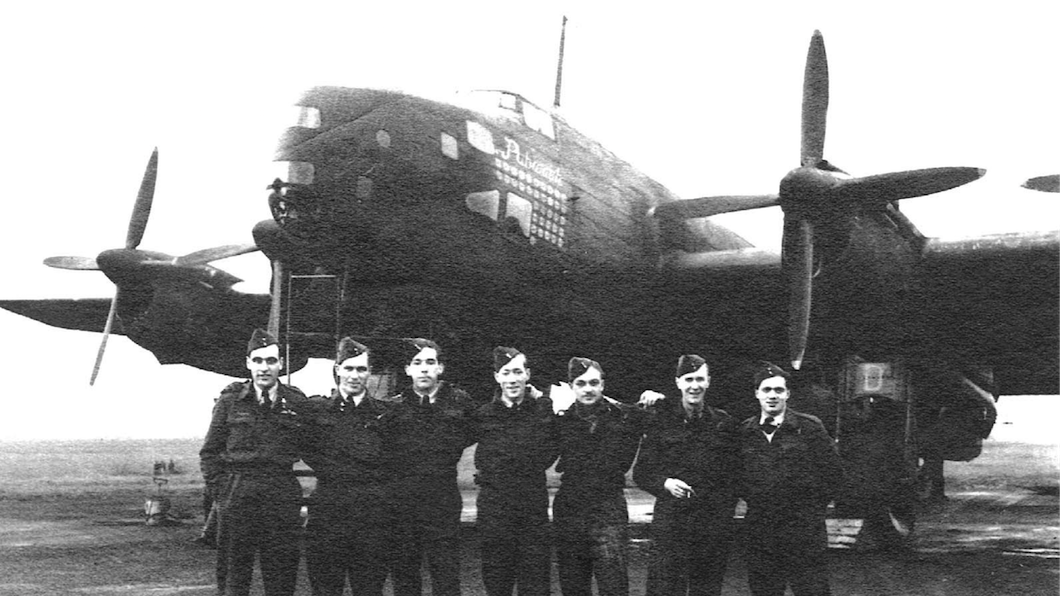Jim Parrott, Harry Pearce, Allan Kurtzhals, Bert Brown, Les Janzen, Gord Olafson, Alex Divitcoff
PER ARDUA AD ASTRA
18 December 1944
It wasn’t a terribly good day all things considered. There was a general optimism that the war was going better but for those on the battle lines the dangers were still front and centre. If you were a sailor in the U.S. 3rd Fleet you would have thought the world was coming to an end. Typhoon Cobra struck with a vengeance in the South Pacific and scattered the fleet. Aircraft carriers with flight decks that were usually sixty feet above the water were now dipping these same decks into the green ocean and struggling to stay upright. Ships were rolling through 100 degrees of arc and visibility was down to a few meters in the torrential rain. Three destroyers were lost in the mountainous waves.
In Europe, it was man pitted against man. The Germans were two days into their Ardennes offensive. They had put together 14 infantry divisions and 5 Panzer divisions and caught the Americans flat-footed. The Germans were trying to split the Allied forces by driving a wedge through Brussels to Antwerp, Belgium. Their efforts resulted in smashing the 106th Division of the American Army. 7,500 Americans surrendered in the largest mass surrender in American fighting history. The resulting Battle of the Bulge was difficult and costly but thankfully it was the last offensive Germany would mount.
For Jim Parrott and his six crew members all this was irrelevant. Their day was going to be long and difficult. It had started the night before at Croft, in the north of England at 2300 hrs. with a Navigation Briefing for their early morning mission. This meeting was followed with a Main Briefing at 2356 hrs. The emotions were running high and there was too much adrenalin in the system to notice the lack of sleep. Their whole attention was focused on the details of the mission ahead.
Shortly after the briefings the crew retired to their quarters, dressed into their flying suits and made their final personal preparations. Maybe it was to jot off a quick letter to a loved one back home or pack a favourite photo inside their suite for good luck but in any case it had to be done in a hurry because they had to get out to the plane and check it for the flight. Although the crew stayed together, it was seldom that they flew the same Halifax two missions in a row. Planes could be out of service because of scheduled maintenance or in order to repair battle damage. This time they were taking the Halifax Mk. III, serial No. NR-118, coded WL-U for identification within the squadron. It had received serious flack damage over Duisburg on a mission to Oberhausen in the Ruhr on the night of November 1/2nd but had been repaired and was now ready for active service. On that mission, one member of its crew had been killed and several were injured but they had managed to carry out their bomb run despite the fact the bomb-aimer had received severe head injuries. Both the pilot and the bomb-aimer were decorated for their heroism. This plane was probably no different from any of the other ten Hallies that were prepped for flight that morning. They had all been on many sorties and the flyers had the utmost faith in the maintenance crews to put the craft in the best flying condition possible. The strong bond among the fliers was not to the airplane but to other members of their own crew. Each crew was a close, cohesive unit that learned to depend on each other implicitly. They spent long hours training together and they tended to stay with each other when not on duty. To know each other, trust each other and to act as a unit in times of emergency could mean the difference between life and death. The support these young men could give each other would be a critical factor in how they sustained the unbelievable stress of knowing just how dangerous their missions were. It was probably known, but not spoken of at the time, that No. 434 Squadron had sustained very heavy losses during the period that it functioned.
In the twenty months that it was operational, from 12 August 1943 to 25 April 1945, 484 officers and airmen went killed or missing on sorties against the enemy, not to count the nine fatalities caused by non-combat accidents. Because the average strength of the unit was about 248, it meant that the squadron was wiped out twice during its short history. Few R.C.A.F. squadrons faced as arduous a level of combat.
Continued:
Many thanks to Leslie Green for providing this article. If you have an airfield story please contact us today.

